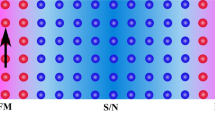Abstract
We present a simple model that supports coexistent superconductive and antiferromagnetic ordering. The model consists of a system of electrons on a simple cubic lattice that move by tunnel effect and interact via antiferromagnetic Ising spin couplings and short-range repulsions: these include infinitely strong Hubbard forces that prevent double occupancy of any lattice site. Hence, under the filling condition of one electron per site and at sufficiently low temperature, the system is an antiferromagnetic Mott insulator. However, when holes are created by suitable doping, they are mobile charge carriers. We show that, at low concentration, their interactions induced by the above interelectronic ones lead to Schafroth pairing. Hence, under certain plausible but unproven assumptions, the model exhibits the off-diagonal long-range order that characterises superconductivity, while retaining the antiferromagnetic ordering.
Similar content being viewed by others
References
Bednorz, J.G., Mueller, K.A.: Possible high \(T_{c}\) superconductivity in Ba-La-Cu-O System. Z. Phys. B 64, 189 (1986)
Anderson, P.W.: The theory of superconductivity in the high \(T_{c}\) cuprates. Princeton University Press, Princeton (1997)
Plakida, N.M.: High Temperature Superconductivity. Springrer, Berlin (1994)
Baskaran, G., Zou, Z., Anderson, P.W.: The resonance valence bond theory of phase transitions and superconductivity in \(La_{2}CuO(4)\) based compounds. Solid State Comms. 63, 973 (1967)
Kivelson, S.A., Rokhsar, D.S., Sethna, J.P.: Topology pf the resonating valence-bond state: solitons and high-\(T_{c}\) superconductivity. Phys. Rev. B 35, 8865 (1987)
Richmond, P., Sewell, G.L.: Electron correlations, magnetic ordering and mott insulation in solids. J. Math. Phys. 9, 349 (1968)
Schafroth, M.R.: Superconductivity of a charged ideal Bose gas. Phys. Rev. 100, 463 (1955)
Cooper, L.N.: Bound electron pairs in a degenerate Fermi gas. Phys. Rev. 104, 1189 (1956)
Leggett, A.J.: Diatomic molecules and Cooper pairs. In: Lec. Notes in Physics, Vol. 115, Pp. 13–27, 1980
Penrose, O., Onsager, L.: Bose-Einstein condensation and liquid Helium. Phys. Rev. 104, 576 (1956)
Yang, C.N.: Off-diagonal long range order and the quantum phases of liquid Helium and of superconductors. Rev. Mod. Phys. 34, 694 (1962)
Sewell, G.L.: Off-diagonal long range order and the Meissner effect. J. Stat. Phys. 61, 415 (1990)
Sewell, G.L.: Off-diagonal long range order and superconductive electrodynamics. J. Math. Phys. 38, 2053 (1997)
Sewell, G.L.: Quantum mechanics and its emergent macrophysics. Princeton University Press, Princeton (2003)
Lieb, E.H., Seiringer, R., Solovej, J.P., Yngvason, J.: The mathematics of the bose gas and its condensation. Birkhauser, Basel (2005)
Kivelson, S.A., Aeppli, G., Emery, J.: Thermodynamics of the interplay between magnetism and high temperature superconductivity. Proc. Nat. Acad. Sci. 98, 11903 (2001)
Gutzwiller, M.: Correlations of electrons in a narrow s-band. Phys. Rev. 137, A1726 (1965)
Saxena, S.S., Agarwal, P., Ahilan, K., Grosche, F.M., Haselwimmer, R.K.W., Steiner, M.J., Pugh, E., Walker, I.R., Julian, S.R., Monthoux, P., Lonzarich, G.G., Huxley, A., Shelkin, I., Braithwaite, D., Flouquet, J.: Superconductivity on the border of itinerant electron ferromagnetism in \(U ge_{2}\). Nature 406, 587 (2000)
Aoki, D., Flouquet, J.: Ferromagnetism and superconductivity in Uranium compounds. J. Phys. Soc. Japan 81, 011003 (2012)
Acknowledgments
The author wishes to thank Walter Wreszinski for some helpful remarks about an earlier draft of this article.
Author information
Authors and Affiliations
Corresponding author
Appendix: Proof of Prop. 3.1.
Appendix: Proof of Prop. 3.1.
As a preliminary to the proof of Prop. 3.1, we define
and establish the following lemma.
Lemma 8.1
The above definitions and assumptions imply that
Proof
By Eqs. (2.9), (3.1) and (8.1),
and hence
Furthermore, by Eq. (2.23) and (3.1),
and, in view of the anticommutation relation (2.8) and Eq. (3.1), we may move the factor \({\alpha }^{\star }(x)\) of the r.h.s. of this formula to the left of all the other factors, where, in view of Eq. (8.3), it is annihilated by the action of \({\alpha }_{-}(x)\). Eq. (8.2) follows immediately from this observation. \(\square \)
Proof of Prop. 3.1
where
Hence, defining
and
we see from Eqs. (2.12), (3.5), (3.6) and (8.4)–(8.8) that in order to establish the formula (3.4), it suffices to prove that
and
Proof of Eq. (8.9)
By Eq. (8.5),
and, by Eqs. (2.13) and (3.1),
In view of the anticommutation relations (2.8) and (2.9), together with Eqs. (3.1) and (8.1), this formula reduces, after some manipulation, to the following equation:
Furthermore, by Eqs. (2.8), (3.1) and (8.1), the terms \({\alpha }_{-}(x_{j})\) and \(({\alpha }_{-}(x_{j}+v)+{\alpha }_{-}(x_{j}-v))\) commute or anticommute with \({\alpha }(x_{j+1}).\ldots {\alpha }(x_{n})\), according to whether \((n-j)\) is odd or even; and, by Lemma (8.1), they annihilate \({\Phi }\). Consequently, by Eq. (8.13), the commutator \([H^{T},{\alpha }(x_{j})]_{-}\) may be replaced by \(-T{\sum }_{v{\in }\mathcal{V}}\bigl ({\alpha }(x_{j}+v)+{\alpha }(x_{j}-v)\bigr )\) in the formula (8.12). On transferring the action of this operator to the function f, we arrive at Eq. (8.9), with \(H^{(n)T}\) given by Eq. (8.6), up to a harmless additive constant.
Proof of Eq. (8.10)
and, by Eqs. (2.7)–(2.9), (2.14) and (3.1),
Hence since, by Eqs. (2.5) , (2.7)–(2.9) and (3.1), \({\alpha }(x_{j})\) commutes with \({\sigma }(x_{j}-u)\),
Further, since
and since, by Eqs. (2.5), (2.7)–(2.9) and (3.1),
it follows from Eqs. (2.21), (8.16) and (8.17) that
Since, for \(u{\in }\mathcal{U}\), the sites \(x_{j}\) and \((x_{j}+u)\) are nearest neighbours and therefore carry opposite spins in the antiferromagnetic configuration,
Hence, by Eqs. (8.15), (8.18) and (8.19),
It follows from this equation and Eq. (8.14) that Eq. (8.10) is satisfied, with \(H^{(n)J}\) given by Eq. (8.4), up to an irrelevant additive constant 2J.
Proof of Eq. (8.11)
Noting that, by Eqs. (2.5), (2.6) and (3.1),
we see that it is a simple matter to prove (8.11) by replacing \(s(x), \, {\sigma }(x), \, u\) and J by \({\nu }, \, 1, \, u+u^{\prime }\) and K, respectively, in the proof of (8.10). This completes the proof of the proposition.
Rights and permissions
About this article
Cite this article
Sewell, G.L. Model of antiferromagnetic superconductivity. Quantum Stud.: Math. Found. 3, 65–78 (2016). https://doi.org/10.1007/s40509-015-0060-8
Received:
Accepted:
Published:
Issue Date:
DOI: https://doi.org/10.1007/s40509-015-0060-8



